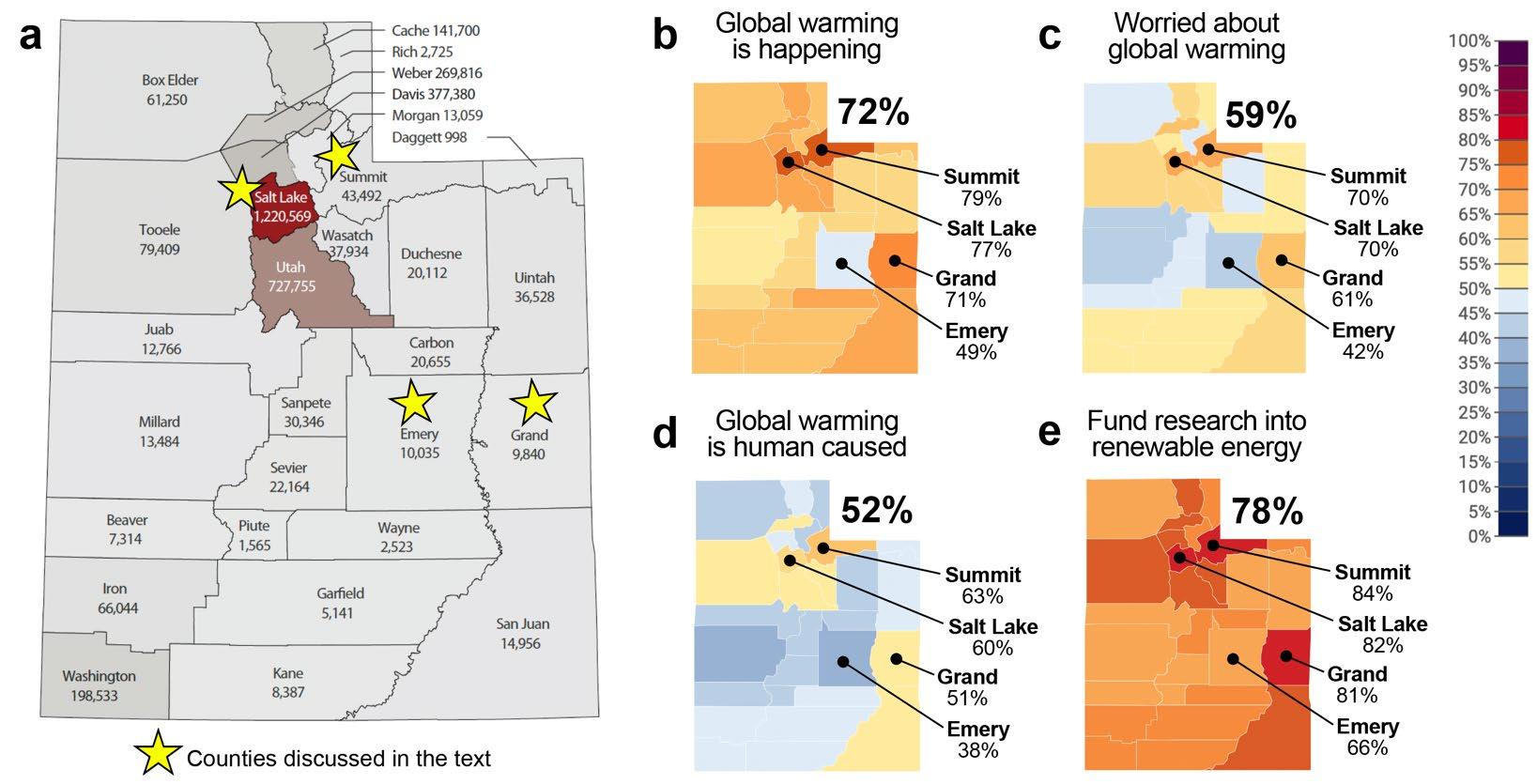What Do Utahns Think About Global Warming and Climate Change?
Scott Hotaling1, Kendall M. L. Becker1, Lendel K. Narine2, Jessica D. Ulrich-Schad3, Roslynn McCann4, Peter D. Howe4
1 Utah State University (USU) Department of Watershed Sciences
2 USU Department of Youth Programs
3 USU Department of Sociology, Anthropology, & Criminal Justice
4 USU Department of Environment and Society
Anthropogenic climate change long-term changes in temperature and weather patterns driven primarily by human activities since the 1800s is the most pressing economic, social, and environmental issue in the 21st century. Addressing climate change requires coordinated efforts to mitigate its causes and adapt to changes at local, regional, national, and global scales (U.S. Global Change Research Program, 2023) However, the degree to which successful policies and actions can be implemented depends, in part, on public opinion
In the western United States, climate change is driving snowpack decline (Siirila-Woodburn et al., 2021), which puts Utah’s water supply at risk. From 2010–2020, Utah was the fastest-growing state in the nation (Kem C. Gardner Policy Institute, 2021). It is also one of the driest, with a population that relies heavily on a declining seasonal snowpack for its drinking water, irrigation, and recreation (Hotaling & Becker, 2024). The degree of climate impacts in Utah will depend on residents’ perceptions of climate change and support for implementing policies to help the state adapt to warmer temperatures, more extreme weather events, and other associated changes. Here, we integrate multiple data sources to summarize the status and trends of Utahns’ opinions on climate change.
Highlights
• In Utah, there is consensus (68%) that global warming is happening, and the strength of this consensus has been steadily rising since 2010.
• Utahns’ support for policy actions that would mitigate global warming is even higher.
• For instance, 78% of Utahns support funding research into renewable energy.
• 71% believe tax rebates should be available for people who purchase energy-efficient vehicles or solar panels.
• 70% believe CO2 should be regulated as a pollutant
Figure 1. Percentages of People in Utah and Surrounding States That Agreed With the Statement “Global Warming Is Happening” in 2023 (based on national survey data)
Source: Marlon et al., 2025
Recent Climate Change in Utah: Water and Snowpack
Utah is a chronically dry state in the western U.S. that relies on a declining seasonal snowpack for the bulk of its water supply (Hotaling & Becker, 2024). While these factors pose environmental challenges for the state, they also make it easier for the effects of global warming and climate change to be directly observed. For instance, the amount of peak snowpack in Utah has declined by 16% since 1979 when large-scale monitoring was first initiated in the western U.S. (Hotaling & Becker, 2024). Less snow means less water is available in late summer for agriculture, household use, and the Great Salt Lake. The decline in snowpack is already reducing revenue for the state’s approximately $2 billion ski industry (Wilkins et al., 2021). Thus, global warming is changing Utah's climate in ways that impact water supply and economic well-being. Looking ahead, Utahns' beliefs about global warming and climate change will influence state- and community-level policies as well as individual actions to mitigate global warming and adapt to new and changing conditions (Figure 1)
Global Warming Versus Climate Change: A Key Distinction
Climate change refers to long-term changes in temperature and weather patterns worldwide. Global warming refers specifically to the earth’s surface getting warmer, which is caused by increasing amounts of greenhouse gases, such as carbon dioxide (CO2) and methane, in the atmosphere. Global warming directly causes the many shifts in weather patterns (e.g., extreme drought and precipitation events) that constitute climate change. Here, we focus on opinions about global warming, the root cause of climate change.
The Data
To summarize Utahns’ opinions about global warming, we used three data sets:
1. Yale Climate Opinion Maps (N > 31,000; 2010–2023), hereafter “Yale survey ” This data set provides estimates of climate change beliefs, perceptions, and policy preferences at national, state, and county scales for the U.S. The estimates are derived from a statistical model based on a large national multi-
year survey using probability sampling methods. A map of the opinions is available online, with additional information in Howe et al., (2015) and Marlon et al., (2022).
2. Utah State University (USU) Extension Climate Change Assessment (N = 73; 2024), hereafter “Extension survey.” In October 2024, USU Extension faculty and staff were surveyed regarding their opinions and needs related to climate change.
3. USU Climate Adaptation Intern Assessment (N = 30; 2024–2025), hereafter “CAIP survey.” In 2024 and 2025, undergraduate participants in the USU Climate Adaptation Intern Program (CAIP) were surveyed regarding their opinions and knowledge about climate change.
U.S. Average
Data source: Marlon et al., 2025
Figure 2. Utahns’ Opinions About Global Warming and Related Policies Over Time Versus the
Utahns’ Opinions About Global Warming: Past and Present
Public opinion can have considerable influence on public policy (Burstein, 2003). The importance of an issue its salience can also enhance the impact of public opinion on policy outcomes (Burstein, 2003). Generally, state-level opinions are reflected in state policy (Lax & Philips, 2012). That is, if there is widespread support for a particular issue and it is salient for voters, then policy change in the direction of the majority is likely to follow.
As of 2023, more than two-thirds of Utahns (68%) agreed with the statement that global warming is happening (Figure 1). This percentage has increased by 14% since 2010, the first year that state-level data were available (Figure 2a). In 2023, Utahns also increasingly agreed that:
• They are worried about global warming (59% in 2023, up from 48% in 2010; Figure 2b)
• Global warming is human-caused (52% in 2023, up from 45% in 2010; Figure 2c).
• Most scientists think global warming is happening (53% in 2023, up from 26% in 2010; Figure 2i)
Agreeing with the statement that most scientists think global warming is happening represents the most striking shift from 2010 to 2023. For this question, Utahns’ agreement has more than doubled from 26% in 2010 to 53% in 2023 (Figure 2i).
In Utah, support for policies that represent responses to climate change is substantially higher than the consensus that global warming is happening. However, support for these policies though still high has mostly declined or stayed the same in recent years. For instance, as of 2023, agreement has declined for the following statements:
In 2023, more Utahns agreed that global warming is happening and why While support for policies that would mitigate global warming has stayed the same or declined since 2010, it remains generally higher than the consensus that global warming is happening
• Research into renewable energy sources should be funded (78% in 2023, down from 85% in 2010; Figure 2d).
• Tax rebates should be available for people who purchase energy-efficient vehicles or solar panels. In 2018, the first year the question was asked, 82% of Utahns agreed that these rebates should be available. By 2023, that number had fallen to 71% (Figure 2e).
• Global warming should be taught in public schools (70% in 2023, down from 74% in 2016; Figure 2h).
Agreement has stayed largely unchanged for two policy-related statements in our subset of the Yale survey:
• CO2 should be regulated as a pollutant (70% in 2023, up from 67% in 2010; Figure 2g).
• Fossil fuel companies should be required to pay a carbon tax which would then be used to offset other taxes by an equal amount (60% in 2023, down from 62% in 2018; Figure 2f).
How Often Do Utahns Discuss Global Warming or Hear About It in the Media?
Conversations and media exposure shape how opinions change over time. While agreement with statements about global warming is generally lower in Utah relative to the U.S., Utahns track the national average regarding communication around global warming (Marlon et al., 2025). According to the Yale survey, Utahns are slightly less likely to discuss global warming at least occasionally (35%) relative to the rest of the U.S. (36%) and are slightly more likely to hear about global warming in the media (33%) relative to the U.S. (32%).
Figure 3 (a) Populations of Utah’s Counties in 2023 (with yellow stars indicating the four counties highlighted in b–e and the text); (b–e) Utahns’ Beliefs, Risk Perception, and Policy Support in 2023
Sources: (a) Harris, 2023; (b–e) Marlon et al., 2025
In Terms of Global Warming Beliefs and Perceptions, Is Utah a Monolith?

Like many states in the western U.S., Utah’s population is not uniformly distributed across the state, nor do all Utahns have a common life experience. Rather, about 80% of Utahns live in populous urban centers along the Wasatch Front (e.g., Salt Lake County; Figure 3a). Thus, we would expect a “rural–urban divide” to exist in Utah. This concept is a powerful theme in American policymaking where people living in rural areas have different opinions from those in urban areas (Brown et al., 2021). And, in many ways, the rural–urban divide does exist in Utah. For example, Utahns living in rural areas were less likely to adopt preventive behaviors in response to the COVID-19 pandemic versus their urban counterparts (Ulrich-Schad et al., 2023). But when it comes to beliefs about global warming, the opinions of Utahns, according to the Yale survey, did not cleanly align with a rural–urban divide. We illustrate these differences using four counties: Salt Lake, Summit, Grand, and Emery (Table 1). These counties represent two regions in Utah, vary in population density, and had relatively high and low agreement with global warming statements (Figure 3).
Table 1. Demographic and Socioeconomic Data for Four Counties in Utah
Salt Lake (Salt Lake City)
(Park City)
(Moab)
(Huntington)
Common industries relative to the rest of Utah
Finance and insurance, real estate
Entertainment, real estate
Utilities, oil, gas, and mining
Sources: Fisk & Ulrich-Schad, 2024; Statistical Atlas, n.d.; Utah Department of Workforce Services, 2025
Three counties in Utah Salt Lake, Summit, and Grand had high agreement that global warming is happening (Figure 3b), they are worried about global warming (Figure 3c), global warming is human-caused (Figure 3d), and research into renewable energy should be funded (Figure 3e). Emery County, in contrast, had lower agreement with these statements. This contrast does not strictly follow rural–urban nor geographic lines. Salt Lake County is urban, while Summit, Grand, and Emery counties are rural (Table 1) Moreover, Grand and Emery counties, despite their differences in climate opinions, are neighbors (Figure 3b).
County-level differences in opinions also do not strictly align with socioeconomic differences. While counties along or near the Wasatch Front, such as Salt Lake and Summit, have some of the highest median household incomes in Utah, Grand County is not among that group (Table 1; Utah Department of Workforce Services, 2025). Rather, of Utah’s 29 counties, Grand County ranks 20th for median household income, below Emery County, which is 18th (Utah Department of Workforce Services, 2025).
Local industries and political views, however, may help explain differences of opinion (Hazboun et al., 2020; Mayer et al., 2021). Residents of Emery County are more likely to be employed by companies in the utility and oil, gas, and mining sectors compared with Utah on average (Table 1; Statistical Atlas, n.d.). In contrast, employment in Salt Lake, Summit, and Grand counties is higher in the finance and insurance, real estate, entertainment, and hospitality sectors compared to Utah on average (Table 1; Statistical Atlas, n.d.). Salt Lake, Summit, and Grand counties were also the only three counties in Utah to vote for a Democratic Party presidential candidate in 2020 and 2024 (The New York Times, 2024).
Differences in Opinion Among Groups
In Utah, opinions about global warming also differ among subsets of the population. Among the general population, as represented in the Yale survey, 59% of Utahns agreed that they are worried about global warming, 40% thought it will harm them personally, and 65% thought this harm will also extend to plants and animals (Figure 4). In 2024, 79% of Extension professionals at USU (N = 73) were worried about global warming (+20% over the statewide average; Figure 4a), and 65% expected global warming to harm them personally (+25% over the statewide average; Figure 4b). Compared to those populations, undergraduate
participants in the USU Climate Adaptation Intern Program (CAIP; N = 30) had even higher rates of agreement across these three questions Indeed, 97% of this student group was worried about global warming (Figure 4a), 83% expected it to harm them personally (Figure 4b), and 100% of the group expected global warming to harm plants and animals (Figure 4c)
Figure 4 Opinions About Global Warming for Different Groups in Utah Based on the Yale Survey (Utah), Extension Survey (USU Extension professionals), and CAIP Survey (USU Climate Adaptation Intern Program participants)
Data source: Marlon et al., 2025
Conclusion
Global warming and climate change are widely considered the most important contemporary environmental issues facing humanity, yet they are also some of the most polarizing politically (Fisher et al., 2013). In Utah, there is widespread consensus that global warming is happening, and the strength of this consensus has been steadily rising since 2010 (Figures 1 and 2). Over the last 14 years, some public opinion metrics have risen dramatically (e.g., perception of scientific consensus on global warming; Figure 2i) while others have been largely stable (e.g., if fossil fuel companies should be required to pay a carbon tax; Figure 2f).
Utah’s support for policies, such as funding research into renewable energy or requiring fossil fuel companies to pay a carbon tax, is generally high (≥ 60%) and reflects nationwide trends (Figure 2; Marlon et al., 2022). However, variation across Utah’s counties does not follow clear rural–urban nor socioeconomic divides (Figure 3). Rather, county-level opinions may be linked to prevailing economic industries and political views
Differences among groups can also provide useful insight into support for or against climate change policy (Figure 4) USU Extension professionals work to “provide research-based programs and resources to improve the lives of individuals, families, and communities throughout Utah” and are more concerned about global warming than the state as a whole (USU Extension, n.d.). Motivated college students are the most concerned.
Taken together, there is widespread and growing consensus among Utahns that global warming and climate change are important environmental issues in the state. There is also substantial and generally higher statewide support for policies that could mitigate global warming, such as funding research into renewable energy sources and requiring fossil fuel companies to pay a carbon tax (Figure 2; Brunner & Ryder, 2023; Schad & Givens, 2023). Support for these policies could be motivated by dual benefits. For instance, implementing a carbon tax could provide the dual benefit of also improving air quality (Cameron et al., 2024; Michaels et al., 2024), another major environmental concern in the state (Flowerday et al., 2023; Schad & Givens, 2023).
Acknowledgments
This publication was supported by the “Secure Water Future” project funded by an Agriculture and Food Research Initiative Competitive Grant (#2021-69012-35916) from the USDA National Institute of Food and Agriculture. Support also came from USU Extension and USU Extension Water Initiative Grants. Input from participants in the Climate Adaptation Intern Program (CAIP) improved this fact sheet. USU Institutional Review Board approval was secured for both USU survey data sets included in this fact sheet: Extension (#14624) and CAIP (#14074). The Yale Program on Climate Change Communication bears no responsibility for the analyses or interpretations of the data presented here.
For questions or feedback, contact Scott Hotaling at scott.hotaling@usu.edu
References
Ahmed, M. N. Q., Givens, J. E., Howe, P. D., & Ulrich-Schad, J. D. (2023). Utahns’ perceptions of climate change and disaster vulnerabilities. Utah People and Environment Poll, Utah State University. https://digitalcommons.usu.edu/canri_projects/11/ Brown, T., Mettler, S., & Puzzi, S. (2021, November 29). When rural and urban become “us” versus “them”: How a growing divide is reshaping American politics. The Forum, 19(3), 365–393. https://doi.org/10.1515/for-2021-2029
Brunner, E., & Ryder, S. (2023). Utahns strongly support renewable energy sources such as solar and wind. Utah People and Environment Poll, Utah State University. https://digitalcommons.usu.edu/cgi/viewcontent.cgi?article=1007&context=canri_projects Burstein, P. (2003). The impact of public opinion on public policy: A review and an agenda. Political Research Quarterly, 56(1), 29–40. https://doi.org/10.2307/3219881
Cameron, R., Becker, K. M. L., Lamm, A. E., & Hotaling, S. (2024). Could a carbon tax improve Utah's air quality and mitigate climate change? [Fact sheet]. Utah State University Extension. https://digitalcommons.usu.edu/extension_curall/2447/
Fisher, D. R., Waggle, J., & Leifeld, P. (2013). Where does political polarization come from? Locating polarization within the US climate change debate. American Behavioral Scientist, 57(1), 70–92. https://doi.org/10.1177/0002764212463360
Fisk, S. & Ulrich-Schad, J. D. (2024). Environmental views on the rural to urban continuum. Utah People and Environment Poll, Utah State University. https://digitalcommons.usu.edu/canri_projects/13
Flowerday, C. E., Thalman, R., & Hansen, J. C. (2023). Twenty-year review of outdoor air quality in Utah, USA. Atmosphere, 14(10), 1496. https://doi.org/10.3390/atmos14101496
Harris, E. (2023). State and county population estimates for Utah: 2023. Kem C. Gardner Policy Institute, University of Utah. https://d36oiwf74r1rap.cloudfront.net/wp-content/uploads/UPC-EstimatesDec2023.pdf
Hazboun, S O., Howe, P. D., Coppock, D. L., & Givens, J. E (2020). The politics of decarbonization: Examining conservative partisanship and differential support for climate change science and renewable energy in Utah. Energy Research & Social Science, 70, 101769. https://doi.org/10.1016/j.erss.2020.101769
Hotaling, S., & Becker, K. M. L. (2024). Recent climate change in Utah, 1870–2023 [Fact sheet]. Utah State University Extension. https://digitalcommons.usu.edu/extension_curall/2453/ Howe, P D., Mildenberger, M., Marlon, J. R., & Leiserowitz, A. (2015). Geographic variation in opinions on climate change at state and local scales in the USA. Nature Climate Change, 5, 596–603. https://doi.org/10.1038/nclimate2583
Kem C. Gardner Policy Institute. (2021, April 26). Census 2020: Utah fastest growing state in U.S. https://gardner.utah.edu/news/census-2020-utah-fastest-growing-state-in-u-s/ Lax, J R., & Phillips, J. H (2012). The democratic deficit in the states. American Journal of Political Science, 56(1), 148–66. https://doi.org/10.1111/j.1540-5907.2011.00537.x
Marlon, J. R., Goddard, E., Howe, P. D., Mildenberger, M., Jefferson, M., Fine, E., & Leiserowitz, A. (2025). Yale climate opinion maps 2023. Yale Program on Climate Change Communication. https://climatecommunication.yale.edu/visualizations-data/ycom-us/
Marlon, J. R., Wang, X., Bergquist, P., Howe, P. Leiserowitz, A., Maibach, E., Mildenberger, M., & Rosenthal, S. (2022). Change in US state-level public opinion about climate change: 2008–2020. Environmental Research Letters, 17(12), 124046. 10.1088/1748-9326/aca702
Mayer, A., Hazboun, S. O., & Howe, P. D. (2021). For the love of sun and wind? Proximity to renewable energy facilities and support for renewable power across time and space in the United States. Energy Research & Social Science, 73, 101910. https://doi.org/10.1016/j.erss.2021.101910
Michaels, K., Becker, K. M. L., Lamm, A. E., & Hotaling, S. (2024). Cap-and-trade carbon pricing in Utah: Challenges and potential impact [Fact sheet] Utah State University Extension. https://digitalcommons.usu.edu/extension_curall/2431/
Schad, J. & Givens, J. (2023) How policymakers are addressing Utahns’ environmental concerns. Report to the Governor & Legislature on Utah’s Land, Water, and Air, Utah State University. https://www.usu.edu/ilwa/files/reports/2023/intro.pdf
Siirila-Woodburn, E. R., Rhoades, A. M., Hatchett, B. J., Huning, L. S., Szinai, J., Tague, C., Nico, P. S., Feldman, D. R., Jones, A. D., Collins, W. D., & Kaatz, L. (2021). A low-to-no snow future and its impacts on water resources in the western United States. Nature Reviews Earth & Environment, 2(11), 800–819. https://doi.org/10.1038/s43017-021-00219-y
Statistical Atlas. (n.d.). Industries in Utah https://statisticalatlas.com/state/Utah/Industries
The New York Times. (2024, December 5). Utah presidential election results. https://www.nytimes.com/interactive/2024/11/05/us/elections/results-utah-president.html
Ulrich-Schad, J. D., Givens, J. E., & Beacham, M. (2022). Preventive behaviors along the rural-urban continuum in Utah during the COVID-19 pandemic. Journal of Rural Social Sciences, 37(2), 4. https://egrove.olemiss.edu/jrss/vol37/iss2/4
Ulrich-Schad, J. D., Givens, J. E., Howe, P. D., & Lancaster, C. (2023). Utahns are becoming more likely to say human-caused climate change is happening. Utah People and Environment Poll, Utah State University. https://digitalcommons.usu.edu/canri_projects/5/
U.S. Global Change Research Program. (2023). Fifth national climate assessment. In A. R. Crimmins, C. W. Avery, D. R. Easterling, K. E. Kunkel, B. C. Stewart, & T. K. Maycock, (Eds.), GlobalChange.gov. https://doi.org/10.7930/NCA5.2023
Utah Department of Workforce Services. (2025). Annual income by county. https://jobs.utah.gov/wi/data/library/wages/income.html
Utah State University Extension. (n.d.). About us. https://extension.usu.edu/about-us Wilkins, E. J., Akbar, H., Saley, T. C., Hager, R., Elkin, C. M., Belmont, P., Flint, C. G., & Smith, J. W. (2021). Climate change and Utah ski resorts: Impacts, perceptions, and adaptation strategies. Mountain Research and Development, 41(3), R12–R23. https://doi.org/10.1659/MRD-JOURNAL-D-20-00065.1
In its programs and activities, including in admissions and employment, Utah State University does not discriminate or tolerate discrimination, including harassment, based on race, color, religion, sex, national origin, age, genetic information, sexual orientation, gender identity or expression, disability, status as a protected veteran, or any other status protected by University policy, Title IX, or any other federal, state, or local law. Utah State University is an equal opportunity employer and does not discriminate or tolerate discrimination including harassment in employment including in hiring, promotion, transfer, or termination based on race, color, religion, sex, national origin, age, genetic information, sexual orientation, gender identity or expression, disability, status as a protected veteran, or any other status protected by University policy or any other federal, state, or local law. Utah State University does not discriminate in its housing offerings and will treat all persons fairly and equally without regard to race, color, religion, sex, familial status, disability, national origin, source of income, sexual orientation, or gender identity. Additionally, the University endeavors to provide reasonable accommodations when necessary and to ensure equal access to qualified persons with disabilities. The following office has been designated to handle inquiries regarding the application of Title IX and its implementing regulations and/or USU’s non-discrimination policies: The Office of Equity in Distance Education, Room 400, Logan, Utah, titleix@usu.edu, 435-797-1266. For further information regarding non-discrimination, please visit equity.usu.edu, or contact: U.S. Department of Education, Office of Assistant Secretary for Civil Rights, 800-421-3481, ocr@ed.gov or U.S. Department of Education, Denver Regional Office, 303-844-5695 ocr.denver@ed.gov. Issued in furtherance of Cooperative Extension work, acts of May 8 and June 30, 1914, in cooperation with the U.S. Department of Agriculture, Kenneth L. White, Vice President for Extension and Agriculture, Utah State University.
February 2025
Utah State University Extension
Suggested citation:
Hotaling, S., Becker, K. M. L., Narine, L. K., Ulrich-Schad, J. D., McCann, R., & Howe, P. D., (2025). What do Utahns think about global warming and climate change? [Fact sheet]. Utah State University Extension.











